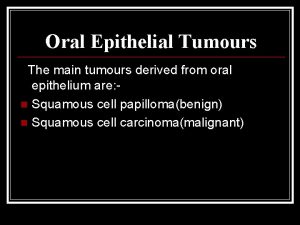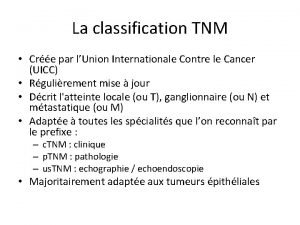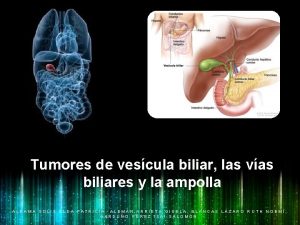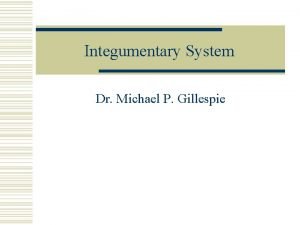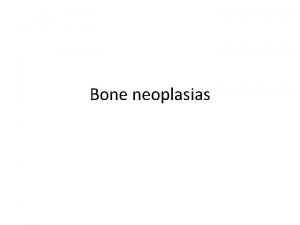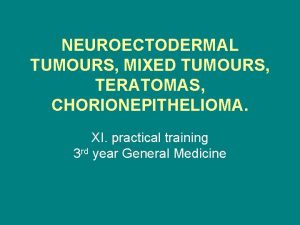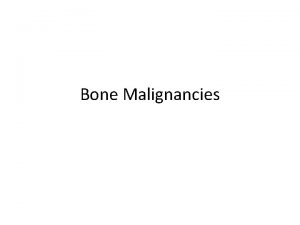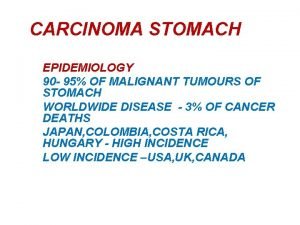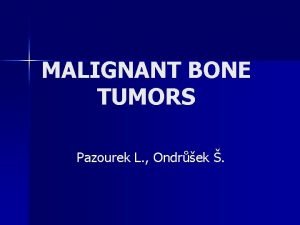TNM Classification of Malignant Tumours 8 th edition












































- Slides: 44

TNM Classification of Malignant Tumours - 8 th edition Changes between the 7 th and 8 th editions January 2018 “We unite the cancer community to reduce the global cancer burden, to promote greater equity, and to integrate cancer control into the world health and development agenda. ”

TNM-8 The TMN 8 th edition was published in December 2016. The UICC TNM Project has published the 8 th Edition of the TNM Classification of Malignant Tumours that comes into effect on January 1, 2017. Since some organizations may not be ready to adopt the new classification, we recommend that the edition of the TNM classification be always included in data reporting. The following is a summary of the changes between the 7 th and 8 th editions of TNM. Major changes are listed and minor changes are identified.

TNM-8 New classifications: • Oropharynx p 16+ve • Unknown primary cervical neck lymph nodes • Skin head and neck cancers • Thymus • Neuroendocrine tumors: pancreas • Osteosarcoma: Pelvic, Spine • Soft tissue Sarcoma: Head and neck, Retroperitoneal, Thoracic and Abdominal Viscera

Major modifications • Head and Neck Nodes • Nasopharynx • Thyroid • Esophagus • Stomach • Anal Cancer • Liver • Lung • Prostate • Ovary

Minor or no modifications • Introduction • Other Head and Neck carcinomas • Hepatobiliary • Small intestine, Colon and rectum • Neuroendocrine • Pleura • Penis, Kidney, Ureter, Bladder, Urethra, • Eye • Malignant Lymphoma

New Structure • Remove C factor from introduction • Clarify ITC • Add Prognostic Grid • Essential TNM • Paediatric Malignancies

ITC - UICC • Isolated tumour cells (ITC) are single tumour cells or small clusters of cells not more than 0. 2 mm in greatest extent that can be detected by routine H and E stains or immunohistochemistry. An additional criterion has been proposed to include a cluster of fewer than 200 cells in a single histological cross section others have proposed that a cluster should have 20 cells or fewer; definitions of ITC may vary by tumour site. • The exception is in Malignant Melanoma of the skin and Merkel Cell Carcinoma, wherein ITC in a lymph node are classified as N 1. These cases should be ana lyzed separately.

Head and Neck Changes • For all sites there are separate classifications for clinical and pathological neck nodes • There is a new classification for p 16 positive oropharyngeal cancers. Tumours that have p 16 immunohistochemistry overexpression. • The classification for nasopharyngeal cancers and thyroid cancers has been modified • The there is a new classification for squamous cell carcinoma of the skin in the head and neck region • There is a new classification for cervical nodal involvement with unknown primary

Cervical Nodes – 8 th edition Clinical Pathological N 1, N 2 a, N 2 b and N 2 c unchanged other than specify without extranodal extension • N 3 a Metastasis in a lymph node more than 6 cm in greatest dimension without extranodal extension • p. N 2 a include single ipsilateral node 3 cm or less with ENE or more than 3 cm and less than 6 cm without ENE • N 3 b Metastasis in a single or multiple lymph nodes with clinical extranodal extension* • p. N 3 a Metastasis in a lymph node more than 6 cm in greatest dimension without extranodal extension * The presence of skin involvement or soft tissue invasion with deep fixation/tethering to underlying muscle or adjacent structures or clinical signs of nerve involvement is classified as clinical extra nodal extension • p. N 3 b Metastasis in a lymph node more than 3 cm in greatest dimension with extranodal extension or, multiple ipsilateral, or any contralateral or bilateral node(s) with extranodal extension

Oropharynx p 16 Positive tumours Clinical and Pathological T categories • T 1 Tumour 2 cm or less in greatest dimension • T 2 Tumour more than 2 cm but not more than 4 cm • T 3 Tumour more than 4 cm in or extension to lingual surface of epiglottis • T 4 Tumour invades any of the following: larynx, deep/ extrinsic muscle of tongue (genioglossus, hyoglossus, palatoglossus, and styloglossus), medial pterygoid, hard palate, mandible*, lateral ptery goid muscle, pterygoid plates, lateral nasopharynx, skull base; or encases carotid artery

Oropharynx p 16 Positive tumours Clinical N categories N 0 No regional lymph node metastasis N 1 Unilateral metastasis, in lymph node(s), all 6 cm or less N 2 N 3 Contralateral or bilateral metastasis in lymph node(s), all 6 cm or less in greatest dimension Metastasis in lymph node(s) greater than 6 cm in dimension Pathological N categories p. N 0 p. N 1 p. N 2 No regional lymph node metastasis Metastasis in 1 to 4 lymph node(s) Metastasis in 5 or more lymph node(s)

Oropharynx p 16 Positive tumours Clinical Pathological Stage I T 1, T 2 N 0, 1 M 0 Stage II T 1, T 2 N 2 M 0 Stage II T 1, T 2 N 2 M 0 T 3 Stage III T 1 T 4 N 3 M 0 Stage III T 3, T 4 N 2 M 0 T 4 Any N M 0 Stage IV Any T Any N M 0 Stage IV Any T Any N M 0 N 0, N 1, N 2 N 0, N 1

Nasopharynx T categories N Categories T 1 Unchanged N 1 Unilateral metastasis, in cervical lymph node(s), and/or unilateral or bilateral metastasis in retropharyn geal lymph nodes, 6 cm or less , above the caudal border of cricoid cartilage T 2 Tumour with extension to parapharyngeal space and/or infiltration of the medial pterygoid, lateral pterygoid, and/or prevertebral muscles T 3 Tumour invades bony structures of skull base cervical vertebra, pterygoid structures, and/or paranasal sinuses T 4 Tumour with intracranial extension and/or involvement of cranial nerves, hypopharynx, orbit, parotid gland and/or infiltration beyond the lateral surface of the lateral pterygoid muscle N 2 Bilateral metastasis in cervical lymph node(s), 6 cm or less above the caudal border of cricoid cartilage N 3 Metastasis in cervical lymph node(s) greater than 6 cm in dimension and/or extension below the caudal border of cricoid cartilage

Nasopharynx

Cervical Node Unknown Primary If EBV positive stage as per nasopharyngeal carcinomas If EBV and p 16 negative clinical and pathological node definitions are as above If p 16 positive stage as per p 16 positive oropharynx carcinomas Stage III T 0 N 1 M 0 Stage IVA T 0 N 2 M 0 Stage IVB T 0 N 3 M 0 Stage IVC T 0 N 1, N 2, N 3 M 1

Thyroid Carcinoma Papillary and Follicular Stage < 55 years old The definition of T 3 has been revised for papillary and follicular and medullary carcinomas T 3 a T 3 b Stage I Any T Any N M 0 Stage II Any T Any N M 1 Tumour more than 4 cm in greatest dimension, limited to the thyroid Tumor of any size with gross extrathyroidal extension invading only strap muscles (sternohyoid, sternothyroid, or omohyoid muscles) The age for a poor prognosis has changed from 45 years to 55 years Stage >55 years old Stage I T 1 a, T 1 b, T 2 N 0 M 0 Stage II T 3 N 0 M 0 T 1, T 2, T 3 N 1 M 0 Stage III T 4 a Any N M 0 Stage IVA T 4 b Any N M 0 Stage IVB Any T Any N M 1

TNM-8 Oesphagogastric Junction Oesophagus and Gastric Carcinomas • A tumour the epicenter of which is within 2 cm of the oesophagogastric junction and also extends into the oesophagus is classified and staged using the oesophageal scheme. Cancers involving the oesophagogastric junction (OGJ) whose epicenter is within the proximal 2 cm of the cardia (Siewert types I/II) are to be staged as oesophageal • Cancers whose epicenter is more than 2 cm distal from the OGJ will be staged using the Stomach Cancer TNM and Stage even if the OGJ is involved.

Oesophagus There are no changes in the definitions of the T, N and M categories. Note there are pathological prognostic groups available for squamous cell carcinoma and clinical and pathological prognostic groups available for adenocarcinoma The AJCC also publish post preoperative therapy prognostic groups for adenocarcinoma and squamous cell carcinoma

Oesophagus Squamous Cell Carcinoma Clinical Stage Pathological Stage 0 Tis N 0 M 0 Stage 0 Tis N 0 M 0 Stage I T 1 N 0, N 1 M 0 Stage IA T 1 a N 0 M 0 Stage II T 2 N 0, N 1 M 0 Stage IB T 1 b N 0 M 0 T 3 N 0 M 0 Stage III T 1, T 2 N 2 M 0 T 3 N 1, N 2 M 0 Stage IVA T 4 a, T 4 b Any N M 0 Stage IVA Any T N 3 T 2 N 0 M 0 Stage II T 3 N 0 M 0 T 1 N 1 M 0 Stage IIIA T 1 N 2 M 0 T 2 N 1 M 0 Stage IIIB T 2 N 2 M 0 T 3 N 1, N 2 M 0 Stage IVB Any T Any N M 1 T 4 a N 0, N 1 M 0 Stage IVA T 4 a N 2 M 0 T 4 b Any N M 0 Any T N 3 M 0 Stage IVB Any T Any N M 1

Oesophagus Adenocarcinoma Clinical Stage Pathological Stage 0 Tis N 0 M 0 Stage I T 1 N 0 M 0 Stage IIA T 1 N 1 IIB T 2 Stage III T 1 N 0 M 0 Stage IA T 1 a N 0 M 0 Stage IB T 1 b N 0 M 0 Stage IIA T 2 N 0 M 0 N 2 M 0 Stage IIB T 1 a, T 1 b N 1 M 0 N 1, N 2 M 0 Stage IIIA T 1 N 2 M 0 T 3, T 4 a N 0, N 1, M 0 T 2 N 1 M 0 Stage IVA T 4 b N 0, N 1 M 0 T 3, T 4 a N 0 M 0 Any T N 2, N 3 M 0 Stage IIIB T 2 M 1 T 2 Stage IVB Any T Any N Tis N 2 M 0 T 3 N 1, N 2 M 0 T 4 a N 1 M 0 Stage IVA T 4 a N 2 M 0 Any N M 0 T 4 b Any T N 3 Stage IVB Any T Any N M 0 M 1

Gastric Carcinoma Adenocarcinoma Clinical Stage I Pathological Stage T 1, T 2, N 0 Stage IIA T 1, T 2, N 1, N 2, N 3 Stage IIB T 3, T 4 a N 0 M 0 Stage 0 Tis N 0 M 0 Stage IA T 1 N 0 M 0 Stage IB T 1 N 1 M 0 T 2 N 0 M 0 T 1 N 2 M 0 T 2 N 1 M 0 T 3 N 0 M 0 T 1 N 3 a M 0 T 2 N 2 M 0 T 3 N 1 M 0 T 4 a N 0 M 0 Stage III T 3, T 4 a N 1, N 2, N 3 M 0 Stage IV T 4 b Any N M 0 Stage IV Any T Any N M 1 Stage IIA Stage IIB

Colon and Rectum Definition of tumour deposit clarified Tumour deposits (satellites) are discrete macroscopic or microscopic nodules of cancer in the pericolorectal adipose tissue’s lymph drainage area of a primary carcinoma that are discontinuous from the primary and without histological evidence of residual lymph node or identifiable vascular or neural structures. If a vessel wall is identifiable on H&E, elastic or other stains, it should be classified as venous invasion (V 1/2) or lymphatic invasion (L 1). Similarly, if neural structures are identifiable, the lesion should be classified as perineural invasion (Pn 1). The presence of tumour deposits does not change the primary tumour T category, but changes the node status (N) to N 1 c if all regional lymph nodes are negative on pathological examination

Colon and Rectum and Appendix Colon and Rectum T and N categories Unchanged M 1 Distant metastasis M 1 a Metastasis confined to one organ (liver, lung, ovary, non regional lymph node(s)) without peritoneal metastases M 1 b M 1 c Metastasis in more than one organ Metastasis to the peritoneum with or without other organ involvement Stage Unchanged except for Stage IVA, IVB, IVC as below Stage IV Any T Any N M 1 Stage IVA Any T Any N M 1 a Stage IVB Any T Any N M 1 b Stage IVC Any T Any N M 1 c Appendix Introduction of Tis (LAMN). Low grade appendiceal mucinous neoplasm confined to the appendix Changes to N and M categories and Stage

Anal Carcinoma Tumours of anal margin and perianal skin defined as within 5 cm of the anal margin are now classified with carcinomas of the anal canal Stage T categories are unchanged Stage I T 1 N 0 M 0 No regional lymph node metastasis Stage IIA T 2 N 0 M 0 N 1 Metastasis in regional lymph node(s) Stage IIB T 3 N 0 M 0 N 1 a Metastases in inguinal, mesorectal, and/or internal iliac nodes Stage IIIA T 1, T 2 N 1 M 0 Stage IIIB T 4 N 0 M 0 Stage IIIC T 3, T 4 N 1 M 0 Stage IV Any T Any N M 1 N 1 b Metastases in external iliac nodes N 1 c Metastases in external iliac and in inguinal, mesorectal and/or internal iliac nodes M categories are unchanged

Liver T 1 a Solitary tumour less than or equal to 2 cm in greatest dimension with or without vascular invasion There are no changes in the definitions of the N and M categories. Stage T 1 b Solitary tumor more than 2 cm in greatest dimension without vascular invasion Stage I A T 1 a N 0 M 0 T 2 Solitary tumour with vascular invasion more than 2 Stage I B T 1 b N 0 cm dimension or multiple tumours, none more than Stage II T 2 N 0 5 cm in greatest dimension M 0 Stage IIIA T 3 N 0 M 0 Stage IIIB T 4 N 0 M 0 T 3 Multiple tumours any more than 5 cm in greatest dimension T 4 Tumour(s) involving a major branch of the portal or hepatic vein with direct invasion of adjacent organs Stage IVA Any T N 1 including the diaphragm), other than the gallbladder Stage IVB Any T Any N or with perforation of vis ceral peritoneum M 0 M 1

Intrahepatic Bile Ducts Ampulla of Vater • Changes in definitions of T 1 and T 2 categories • Changes in Stage • Changes in definitions of T 1, T 2 and T 3 categories and N categories • Changes in Stage Gall Bladder • Changes in definitions of T 2 category and N categories • Change in Stage Perihilar Bile Ducts No Changes Distal Extrahepatic Bile Duct • Changes in definitions of T 1, T 2, T 3 categories and N categories • Changes in Stage Well differentiated Neuroendocrine Tumours of the Gastrointestinal Tract • Pancreas added • Minor changes in T categories. • Changes in N category for Jejunum and Ileum • Minor changes in Stage

Pancreas T 1 Tumour 2 cm or less M category unchanged T 1 a Tumour 0. 5 cm or less T 1 b Tumour greater than 0. 5 cm but no more than 1 cm Stage Tumor greater than 1 cm but no more than 2 cm T 1 c Stage IA T 1 N 0 M 0 Stage IB T 2 N 0 M 0 Stage IIA T 3 N 0 M 0 Stage IIB T 1, T 2, T 3 N 1 M 0 N 2 M 0 T 2 Tumour more than 2 cm but no more than 4 cm T 3 Tumour more than 4 cm in greatest dimension Stage III T 1, T 2, T 3 T 4 Tumour involves coeliac axis, superior mesenteric artery and/or common hepatic artery Stage IV Any T N 1 Metastases in 1 to 3 nodes N 2 Metastases in 4 or more nodes T 4 Any N M 0 Any N M 1

Lung T 1 mi T 1 a T 1 b T 1 c T 2 a T 2 b Tumour 3 cm or less Minimally invasive adenocarcinoma Tumour 1 cm or less Tumour more than 1 cm but not more than 2 cm Tumour more than 2 cm but not more than 3 cm Tumour more than 3 cm but not more than 5 cm; or tumour with any of the following features: Involves main bronchus without involvement of the carina, or invades visceral pleura or associated with atelectasis or obstructive pneumonitis Tumour more than 3 cm but not more than 4 cm Tumour more than 4 cm but not more than 5 cm

Lung T 3 Tumour more than 5 cm but not more than 7 cm or directly invades: parietal pleura, chest wall, phrenic nerve, or parietal pericardium; or separate tumour nodule(s) in the same lobe. T 4 Tumour more than 7 cm or of any size that invades any of the following: diaphragm, mediastinum, heart, great vessels, trachea, recurrent laryngeal nerve, oesophagus, vertebral body, carina; or separate tumour nodule(s) in a different ipsilateral lobe to the primary N Category- No Change M Category M 1 a M 1 b M 1 c Separate tumour nodule(s) in a contralateral lobe; tumour with pleural or pericardial nodules or malignant pleural or pericardial effusion Single extrathoracic metastasis in a single organ Multiple extrathoracic metastasis in a single or multiple organs

Lung Stage IA 1 T 1 N 0 M 0 T 1 mi, T 1 a N 0 M 0 Stage IA 2 Stage IA 3 Stage IB Stage IIA Stage IIB T 1 b N 0 M 0 T 1 c N 0 M 0 T 2 a N 0 M 0 T 2 b N 0 M 0 T 1 a c, T 2 a, b N 1 M 0 T 3 N 0 M 0 Stage IIIA T 1 a c, T 2 a, b N 2 M 0 T 3 N 1 T 4 N 0, N 1 M 0 Stage IIIB T 1 a c, T 2 a, b N 3 M 0 T 3, T 4 N 2 M 0 Stage IIIC T 3, T 4 N 3 Stage IV Any T Any N M 1 Stage IVA Any T Any N M 1 a, b Stage IVB Any T Any N M 1 c M 0

Mesothelioma and Thymus Mesothelioma Minor change in T 1 category Thymus Please see details in Changes in N category Changes in Stage Nicholson AG, Detterbeck FC, Marino M et al. The IASLC/ITMIG thymic epithelial tumors staging project: proposals for the T component for the forthcoming (8 th) edition of the TNM classification of malignant tumors. J Thorac Oncol 2014; 9: s 73 s 80.

Bone and Soft Tissues Sarcoma Bone Soft Tissues sarcoma • No Changes for sarcomas of the Appendicular Skeleton, Trunk, Skull and Facial Bones New T categories for Extremity and Superficial Trunk • New Classifications introduced for Spine and Pelvic Bone Sarcomas T 2 Tumour more than 5 cm but no more than 10 cm T 1 Tumour 5 cm or less T 3 Tumour more than 10 cm but no more than 15 cm T 4 Tumour more than 15 cm New Classification for retroperitoneal sarcoma (same as extremity) Head and Neck and also Thoracic and Abdominal Viscera

Skin carcinomas T categories N Categories for non head and neck T 1 < 2 cm N 1 T 2 > 2 to 4 cm T 3 > 4 cm T 4 a Tumor with gross cortical bone / marrow invasion T 4 b Tumor with skull base or axial skeleton invasion including foraminal involvement and/or vertebral foramen involvement to the epidural space Metastasis in a single lymph node 3 cm or less N 2 Metastasis in a single ipsilateral lymph node, more than 3 cm but not more than 6 cm or in multiple ipsilateral nodes none more than 6 cm N 3 Metastasis in a lymph node more than 6 cm Head and Neck Region N categories as defined in slide 9

Skin carcinomas Stage I T 1 N 0 M 0 Stage II T 2 N 0 M 0 Stage III T 3 N 0 M 0 N 1 M 0 Stage IVA T 1, T 2, T 3 N 2, N 3 M 0 T 4 Any N M 0 Any N M 1 T 1, T 2, T 3 Stage IVB Any T

Malignant Melanoma & Merkel cell carcinoma Cutaneous Melanoma Merkel cell • p. T 1 a and p. T 1 b categories introduced • p. T 1 a < 0. 8 mm • p. T 1 b > 0. 8 mm 1 mm • M category • M 1 a Skin, subcutaneous tissue or non regional lymph nodes • M 1 b Lung • M 1 c Other non central nervous system sites • M 1 d Central nervous system • M Category modified by elevated or non elevated LDH Stage Revised • Changes in c. N and p. N classification and in Stage

Genitourinary Malignancies and Adrenal Cortex Prostate Penis T 4 N 0 M 0 is now stage III Changes in T category and pathological N category WHO Grade should be used to record tumour grade Kidney Stage N 2 is eliminated Stage I T 1, T 2 a N 0 M 0 Stage II T 2 b 2 c N 0 M 0 Stage III T 3, T 4 N 0 M 0 Stage IV Any T N 1 M 0 Any T Any N M 1

Genitourinary Malignancies and Adrenal Cortex Urinary bladder Adrenal Cortex The M category is subdivided Change in Stage M 1 a Non regional lymph nodes Stage I T 1 N 0 M 1 b Other distant metastasis Stage II T 2 N 0 M 0 Stage III T 1, T 2 N 1 M 0 Minor changes to Stage Urethra Changes to N category N 1 Metastasis in a single lymph node N 2 Metastasis in multiple lymph nodes T 3, T 4 N 0, N 1 M 0 Stage IV Any T Any N M 1

Ovary – 8 th ed TNM and Ovary, Fallopian Tube and Primary Peritoneal Carcinoma based on FIGO 2014 FIGO has published a new classification for ovarian cancer* This classification incorporates cancers of the fallopian tube and primary peritoneal carcinomas Staging classification for cancer of the ovary, fallopian tube, and peritoneum. Jaime Prat; for the FIGO Committee on Gynecologic Oncology. International Journal of Gynecology and Obstetrics 124 (2014) 1– 5

Ovary, Fallopian Tube and Primary Peritoneum T 1 Limited to the ovaries I T 3 and/or Peritoneal metastasis beyond pelvis Tla One ovary, (capsule intact) IA N 1 or fallopian tube and/or regional lymph node metastasis III T 1/T 2 N 1 Retroperitonal nodes only IIIA 1 Tlb Both ovaries, capsule intact IB T 1/T 2 N 1 a < 10 mm IIIA 1 i TIc 1 Surgical Spill IC 1 T 1/T 2 N 1 b > 10 mm IIIA 1 ii TIc 2 Capsule ruptured before surgery or IC 2 T 3 a N 0/N 1 Microscopic peritoneal metastasis tumour on surface of ovary or tube T 3 b N 0/N 1 Macroscopic peritoneal metastasis < 2 cm IIIB TIc 3 Malignant cells in ascites or peritoneal washings IC 3 T 3 c N 0/N 1 Peritoneal metastasis >2 cm IIIC T 2 Pelvic extension below pelvic brim or primary peritoneal cancer II M 1 Distant metastasis (excludes peritoneal) IV T 2 a Uterus, tube(s), ovary (ies) IIA T 2 b Other pelvic tissues IIB M 1 a M 1 b Pleural effusion positive cytology IVB Parenchymal metastases IVB

Malignant Lymphoma A recent consensus conference in Lugano suggested a more simplified system putting together stage I and II as Limited Stage and stage III and IV as Advanced Stage lymphoma. Limited Stage • Stage II • Bulky Stage II Advanced Stage • Stage III • Stage IV Cheson BD, Fisher RI, Barrington SF, et al. Recommendations for initial evaluation, staging, and response assessment of Hodgkin and non Hodgkin lymphoma: the Lugano classification. J Clin Oncol. 2014; 32: 3059 3068

Ophthalmic Tumours Carcinoma of Conjunctiva Retinoblastoma • • Minor changes to definition of T 1 and T 2 categories Changes to definition of c. T 1 and c. M categories and p. T and p. M categories Malignant Melanoma of Conjunctiva Sarcoma of the Orbit • • Changes to the pathological T categories Malignant Melanoma of Uvea • Carcinoma of Lacrimal Gland Iris • Minor changes to definition of T 1 and T 2 categories Minor changes to definition T 2 category • Changes to the T categories

Essential TNM Information on anatomical extent of disease at presentation is often not available for cancer registries in low and middle in come countries either because of inability to perform necessary investigations or because of lack of recording of information. The UICC TNM Project has with the International Agency for Research in Cancer and the National Cancer Institute developed “Essential TNM” that can be used to collect stage data when complete information is not available. When the T, N, and M categories have not been the cancer registrar can code the extent of disease according to the Essential TNM scheme. The schema for breast, colorectal cancer, prostate and cervix cancer published in the 8 th edition TNM Classification and are available on the website.

Paediatric Tumours A consensus meeting held in 2014 recommended a tiered staging system with more detailed systems for well resourced cancer registries and less detailed systems for registries with limited recourses and access The recommendations for tier 1 and 2 follow are published the 8 th edition TNM Classification of Malignant Tumours. For some cancers recommendations are the same as described earlier for adult patients.

Thank you www. uicc. org UNION FOR INTERNATIONAL CANCER CONTROL UNION INTERNATIONALE CONTRE LE CANCER 62 route de Frontenex, 1207 Geneva, Switzerland T. +41 (0)22 809 1811 F. +41 (0)22 809 1810
 Tongue rough edges
Tongue rough edges Prostate cancer tnm classification
Prostate cancer tnm classification Tnm esofago
Tnm esofago Tnm stage lung cancer
Tnm stage lung cancer Superior sulcus of lung
Superior sulcus of lung Tumore ampolla vater sopravvivenza
Tumore ampolla vater sopravvivenza Tnm yp
Tnm yp Crc staging
Crc staging Colon cancer t stage
Colon cancer t stage Ajcc breast cancer staging 8th edition poster
Ajcc breast cancer staging 8th edition poster Tnm breast cancer
Tnm breast cancer Victoria imaz olguin
Victoria imaz olguin Tnm 8 head and neck
Tnm 8 head and neck Gulf university
Gulf university Tnm ovario
Tnm ovario Carcinoma bronquioloalveolar
Carcinoma bronquioloalveolar Sirh tnm
Sirh tnm Tnm colangiocarcinoma
Tnm colangiocarcinoma Classificazione di bormann
Classificazione di bormann Vetsuppressie
Vetsuppressie Manchester staging of breast cancer
Manchester staging of breast cancer Benign vs malignant
Benign vs malignant Malignant neuroleptic syndrome
Malignant neuroleptic syndrome Nail body
Nail body Cataractectomy
Cataractectomy Malignant and benign tumors
Malignant and benign tumors Kitwoods flower
Kitwoods flower Neuroleptic malignant syndrome
Neuroleptic malignant syndrome Hypertensive encephalopathy
Hypertensive encephalopathy Background
Background Malignant neoplasm of the blood-forming organs
Malignant neoplasm of the blood-forming organs Malignant mesothelioma
Malignant mesothelioma Malignant neoplasm of liver
Malignant neoplasm of liver Liposarcoma
Liposarcoma Md frcpc definition
Md frcpc definition Cachexia
Cachexia Schizophrenia disorganized behavior
Schizophrenia disorganized behavior Hypertensive emergency vs urgency
Hypertensive emergency vs urgency Local invasion
Local invasion Hematocrit
Hematocrit Malignant hypertension
Malignant hypertension Mis chapter 6
Mis chapter 6 Zulily case study
Zulily case study Eager learner examples
Eager learner examples Semi-tabulation presentation
Semi-tabulation presentation
